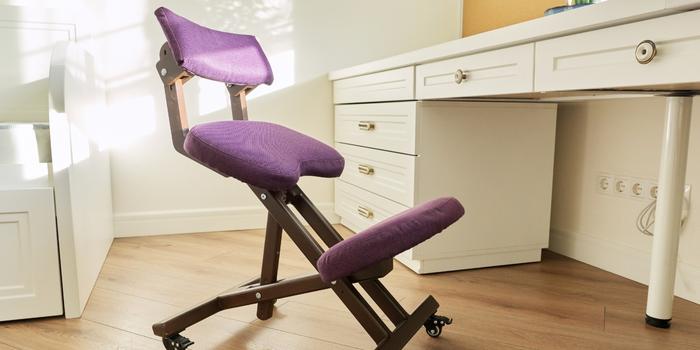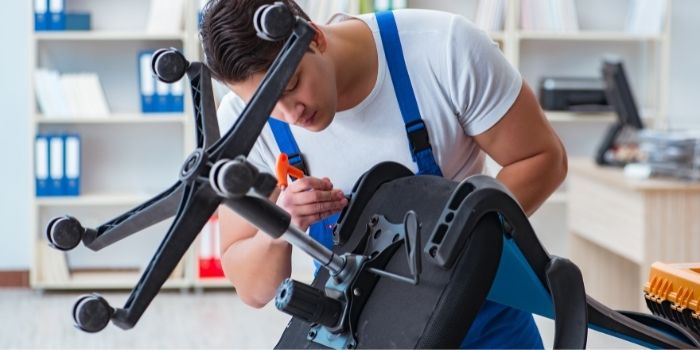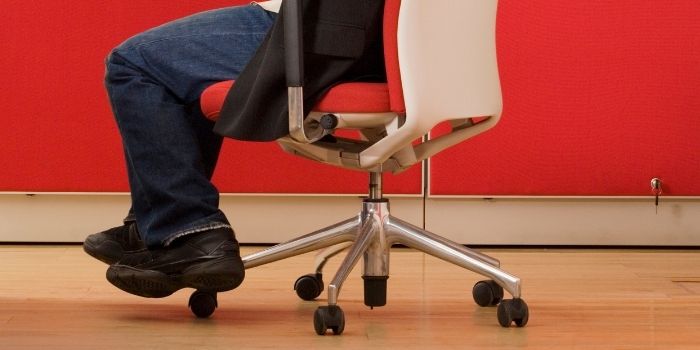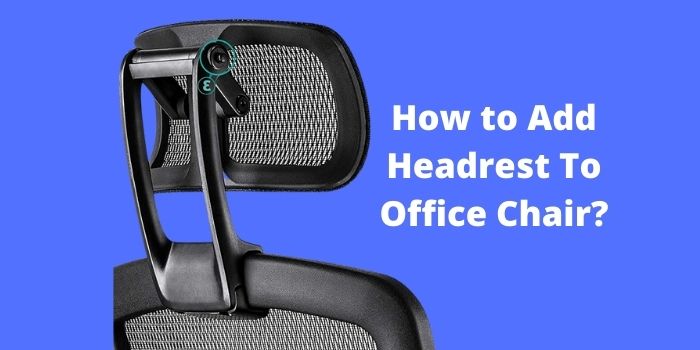How to Sit in a Kneeling Chair Properly?

As people spend more and more time sitting in chairs, there is a greater need for chairs that are both comfortable and ergonomic. Sitting in a kneeling chair takes the pressure off your lower back, and can help to alleviate pain.
In this post, we’ll show you how to sit in a kneeling chair correctly, so that you can get the most out of this type of chair.
What is Kneeling Chair?
A kneeling Chair is a type of chair that is designed to reduce back pain by aligning the spine and providing support for the lower back. This type of chair is often used in office settings, but can also be used at home. Kneeling chairs are becoming increasingly popular as people look for ways to reduce their risk of developing back problems.
The kneeling chair is different in appearance and sitting style. It’s not that ordinary office chair one might assume. Its brief history dates back to 1979 when Hans Christian Mengshoel first developed this modern kneeling chair.
So, apart from the strange design, what is so special about this chair? How is a kneeling chair different from an ordinary office chair?
Well, a kneeling chair offers some benefits like lowering back pain and posture correction. The researchers suggest that ergonomic chairs are beneficial for improved posture and back pain. These benefits make it stand out among simple chairs.

A regular office chair puts immense pressure on just the lower spine and buttocks. It can lead to back pain and posture problems in the long run. Contrary to the traditional office chair, a kneeling chair divides even pressure on knees, shins, spine, and buttocks. Thanks to its unique design. It keeps lower back pain away and engages core muscles.
Who needs a kneeling chair?
Kneeling chairs are an excellent option for people who sit at a desk all day. They look like regular desks but the chair is designed to be set down in front of it and then you lean forward on your knees while working. This position reduces pressure from your back and hips which can cause pain over time. It also gives support to the spine, which can reduce fatigue.
We often have to work our asses off by sitting for long hours. But this routine is terrible for our posture and can cause back pain. As shown in a report by the UCLA health organization, sitting for long hours inserts excess pressure on the lumbar spine, neck, arms, and leg. It causes massive strain on the spinal discs and back muscles.
An ergonomic chair is a great solution when you have to sit and work for long hours either for sewing, studying, drawing, working on laptops, etc.
Benefits Of Kneeling Chair

1. Get a Better Knee-bend
If you cannot get comfortable while sitting at your desk, you are not getting the most out of your workday. Since kneeling chairs let you balance by bending forward from the hips, they allow you to extend your legs and knees beneath your desk without straining.
The added benefit of maintaining a bent-knee position is that you are able to breathe more deeply, which helps you concentrate and feel less tired after long hours spent at your desk.
2. Improve Your Posture
Proper posture is crucial for preventing fatigue in the back and neck as well as reducing the risk of musculoskeletal injuries while working at a desk job.
A study published in the journal Applied Ergonomics found that children who use kneeling chairs are less likely to slouch than their peers: maintaining a healthy work posture is easiest for kids, which teaches them how to stand or sit properly as adults.
3. Lessen Your Risk of Disease
Prolonged periods of time spent sitting can increase your risk for health conditions such as heart disease, diabetes, obesity, and cancer. Even if you exercise regularly or spend a lot of time walking, experts warn that these activities cannot undo the damage caused by prolonged periods of inactivity at work.
Luckily, using a kneeling chair is an easy way to counteract the adverse effects of a sedentary lifestyle. Sitting on a kneeling chair for just an hour per day has been shown to improve posture, breathing, and circulation: keeping you healthy and active throughout the workday.
How To Use A Kneeling Chair? Things to look into before sitting:
Sitting in a kneeling chair is like a mindful task. You need to take care of the height, angle, and other matters before sitting on the chair.
I wonder why the heck scientists put so much thought into merely designing a chair. Well, it does add a luxurious experience to our lives.
- Height: If you’re tall, sitting in a kneeling chair might cause a problem for you, primarily because of your tall legs. So be mindful of the height adjustment of the chair according to your requirement. Go for the chairs, which are adjustable if you can afford them.
- Angle: While sitting in ordinary office chairs, your legs and thighs make almost a 90 degrees angle, which might exert more strain on your lumbar spinal cord. This would ruin your posture correction plans and back pain relief efforts. Kneeling chairs have knee resters in the front to cope with the stated problem. Change the angle according to your need in which you feel comfortable. If you don’t have an adjustable chair, try to buy one with a 25-30 degrees angle between the knees and the sitting pads.
- To sit correctly is essential. Otherwise, you’ll do more damage instead of a benefit to your posture. Imagine getting knee strain due to a lack of sitting knowledge. Not desirable, right? You might find it uncomfortable initially and come to this conclusion on your own that all kneeling chairs are utter trash. But the problem might be that you aren’t using it correctly.
The kneeling chair provides you with the maximum result if it aligns best with your needs. Adjust the angle and height according to your requirement to get the utmost comfort and convenience.
How To Sit in a Kneeling Chair Properly?
If you’re finding it uncomfortable while sitting on the kneeling chair, then you are probably doing it wrong. Let’s have a read on how to sit on a kneeling chair properly.
- It’s pretty simple to sit on a kneeling chair. Just sit as we do in ordinary chairs. Place your bottom on the chair first while your feet are touching the floor.
- After that, move to the kneeling position. Place one leg on the knee cushion. Then, Repeat the same with the other leg.
- It will make you in a position if you are leaning in the forward direction slightly.
Most users have never experienced an ergonomic chair before. Don’t feel as if you’ve wasted your money just after two days of use. Bear in mind that It takes time to become habitual to this new sitting position. It causes discomfort and muscle stiffness at the start. But that’s normal. As time passes, it allows you to adjust. Your muscles develop the required strength. Eventually, everything turns out fine.
Don’t put too much weight on the knees pad. It might cause lower blood circulation in the lower limbs. Excess of the weight will still be on your bottom, while knee pads serve for additional support. Make sure not to lean too forward; neither do entirely backward.
Tips To Bring Variations While Sitting On The Kneeling Chair?
- Change the sitting position frequently. As a kneeling chair confine your legs at knee pads, it can cause lower circulation in the lower limbs. So, in this case, it’s better to switch sitting positions from time to time. Like you can try resting one knee on the pad and the other on the floor. Then reverse the roles of legs. Or you can put both legs on the floor for some time, then return to your original position.

- Don’t throw away your office chair. You can use a kneeling chair and an office chair interchangeably for some time until your body becomes used to this new style of sitting.
- Switching between a kneeling chair and a standing desk is an ideal match for efficient working. A standing desk ensures more body movement and increased physical activity. But using it for too long can cause discomfort and pain in the feet. Similarly, sitting on the kneeling chair for the whole time might not be ideal as a standing desk is generally height adjustable. So you can quickly lower its size and can use it along with a kneeling chair.

- Take brief breaks after working for a while. Taking short intervals off will not only help you relieve your muscle fatigue, but it will also enhance your productivity, relaxes your eyes, and have many other benefits. You can do stretches during this time. The Time interval of these breaks varies among experts, but you can apply the Pomodoro technique, which means taking 5 mins rest after every 25 mins.
FAQs
Are kneeling chairs uncomfortable?
Not really. The kneeling chairs are not uncomfortable. It is just a misconception. Although, It does cause muscle stiffness at the start. But as time passes, you become habitual with this new sitting position. It helps you in better posture and relieves back pain.
Can you use a kneeling chair all day?
Using a kneeling chair for a whole day isn’t preferred. It might cause pain in your lower limbs. If you take mini breaks from time to time, change your sitting position on a kneeling chair frequently, or shift to ordinary chairs or a standing desk during working. Then, you can use a kneeling chair the entire day without any worry.
Is kneeling at the desk better than sitting?
Sitting on an ordinary chair for long hours can cause bad posture and back pain, as the whole strain is being put upon the lower spine and neck.
But, kneeling reduces the angle from 90 degrees to 60-70 degrees, distributing weight in the thighs, knees, and spine. So it causes less strain and is suitable for posture correction and reducing back pain.
Are kneeling chairs good for you?
Yes, kneeling chairs are an excellent fit for you. Even if you have to sit and work for longer hours, A kneeling chair effectively relieves back pain and maintains a correct posture.
How long should you sit in a kneeling chair?
Kneeling chairs vary in design, so the length of time one can sit comfortably depends on the chair’s design and how it fits your body. In general, it is recommended to limit sitting in a kneeling chair to 45 to 50 minutes or less at a time, taking short breaks every 40-45 minutes. This helps avoid discomfort and potential health risks associated with sitting in an improper posture for extended periods of time.
As each person is unique, it’s important to listen to your body and adjust the amount of time you sit in a kneeling chair accordingly. If you experience any discomfort while using the chair, take a break or switch to another type of seating arrangement.
Final Thoughts
When sitting in a kneeling chair, it is important to keep your back straight and your shoulders relaxed. You should also avoid crossing your legs or leaning forward while sitting in the chair. It is best to sit with your feet flat on the floor, but you can also use a small stool or ottoman to prop them up if needed.
If you are new to using a kneeling chair, it is important to start slowly and increase the amount of time you spend in the chair gradually. You may also want to consult with a physical therapist or healthcare professional to ensure that the chair is appropriate for your needs.






